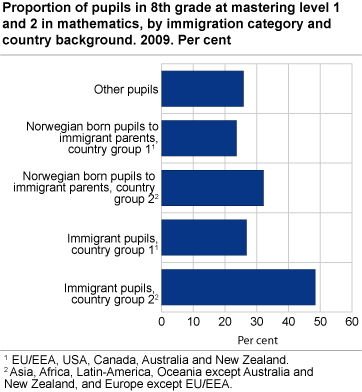Content
Published:
This is an archived release.
Immigrant pupils achieve lower scores
Overall, immigrant pupils and Norwegian-born pupils to immigrant parents achieve lower scores than other pupils on most of the national tests. However, nuances are introduced when country background and parents’ educational attainment is taken into account.
The results of the national tests in 2009 show, as in previous years, that boys achieve higher scores than girls in mathematics, whereas girls on average do better than boys in reading Norwegian. These gender differences can be observed both in 5t h and 8t h grade. In reading English, there are only minor differences.
There is also a positive correlation between pupils’ achievements in the national tests and their parents’ level of education, which can be observed over time.
Half of the immigrant pupils on lowest mastering level in mathematics
On average, immigrants and Norwegian-born pupils to immigrant parents achieve lower scores than other pupils. The only exception is English 5t h grade, where Norwegian-born pupils to immigrant parents have the highest scores. Close to 48 per cent of the immigrant pupils in 5t h grade score at the lowest mastering level in reading, whereas only about 25 per cent of the pupils with non-immigrant parents do the same. The gap between these groups is almost equally pronounced in mathematics.
The findings are somewhat modified if we take into consideration the parents’ level of education when comparing the various immigration categories. If we only compare pupils whose parents have less than tertiary education, there are only minor differences in the results achieved in English and mathematics between Norwegian-born pupils to immigrant parents and pupils with non-immigrant parents. However, the scores amongst immigrant pupils remain, on average, significantly lower than those of the other two groups, even when the parents’ level of education is taken into account.
There are pronounced variations in the results of pupils with different country backgrounds within the two groups ‘immigrant pupils’ and ‘Norwegian-born pupils with immigrant parents’. It is particularly immigrant pupils and Norwegian-born pupils to immigrant parents from country group 2 who attain lower results than other pupils.
|
National tests in 5th and 8th grade have been conducted annually since 2007. The tests in 5th grade have three mastering levels, where 3 represents the highest score and 1 is the lowest. The tests in 8th grade have five mastering levels, where 5 is the highest score and 1 is the lowest. The results presented are proportions at different assessment levels or mastering levels. More detailed information about the levels and boundaries between levels is available in about the statistics . |
1 Country group 1= EU/EEA, USA, Canada, Australia and New Zealand
Country group 2 = Africa, Latin-America, Oceania except Australia and New Zealand, and Europe except EU/EEA
Tables:
- Table 1 Distribution of pupils by mastering levels in national tests in 5th grade, by parents' educational attainment level and the centrality of pupils' school municipality. 2008-2009. Per cent
- Table 2 Distribution of pupils by mastering levels in national tests in 8th grade, by parents' educational attainment level and the centrality of pupils' school municipality. 2008-2009. Per cent
- Table 3 Distribution of pupils by mastering levels in national tests in 5th grade, by gender and parents' educational attainment level. 2008-2009. Per cent
- Table 4 Distribution of pupils by mastering levels in national tests in 8th grade, by gender and parents' educational attainment level. 2008-2009. Per cent
- Table 5 Distribution of pupils by mastering levels in national tests in 5th grade, by gender and immigration category. 2008-2009. Per cent
- Table 6 Distribution of pupils by mastering levels in national tests in 8th grade, by gender and immigration category. 2008-2009. Per cent
The statistics is now published as Marks and national tests, lower secondary school.

